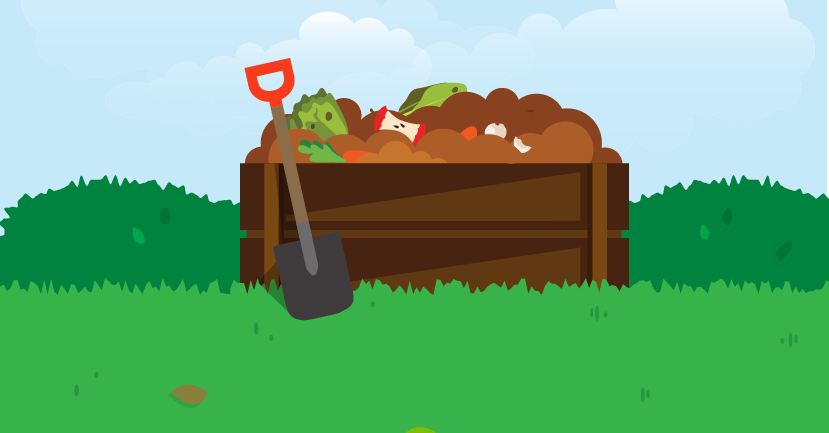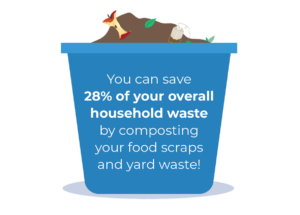
Written by our friends at Green Mountain Energy
Composting is a great, easy way to green up your daily routine. Green Mountain Energy has what you need to know to get started on your composting journey.
When you throw away food scraps and yard waste, there’s a good chance it will end up in a landfill, creating more methane gas. But did you know there’s a way to turn 28% of that waste into something useful for our environment? That’s the kind of impact the average household could have, just by incorporating composting into their daily lives.
If you’ve never considered composting before, don’t sweat. Green Mountain Energy is here to show you how with some simple tips for beginners who are ready to do some good for the planet.
What can you compost?
Compost is used to nourish plants and fortify the soil, so anything you put into your compost bin should be natural — think fruit and vegetable peels, coffee grounds, eggshells, paper, yard trimmings and even tea bags. You can also include things like fireplace ashes, dryer lint and even the contents of your vacuum cleaner. Have four-legged family members? Good news: You can compost all that hair they generously leave behind.
Don’t include things like dairy, meat, bones, oils and fats, charcoal ash, diseased plant clippings or anything that has been treated with pesticides.
A quick tip here: If you buy conventional bananas and oranges, the peels usually contain pesticides. You may want to skip those, or switch to organic. Also avoid pet waste like cat litter and puppy “presents.” Those materials could contaminate the compost and harm plants or soil.

What do you need?
At Green Mountain Energy, we’re working to show the world how easy it can be to make a green impact. That’s why we think composting is a great addition to any household: It works just about anywhere, and you don’t need many supplies to get started.
You can compost indoors or outdoors, so even if you don’t have a backyard, you can still start a small compost pile in your kitchen or on an apartment patio. For indoor or patio composting, you’ll need a special indoor composting bin, available online or from home improvement stores. And here’s the best part — you don’t need earthworms indoors!
Backyard composting is a little more flexible. You can use a composting bin, or you can start a compost pile in a shady area. If you go the DIY route, the compost needs to sit on bare dirt to attract worms and beneficial bacteria, so be mindful as you choose a spot.
Once you’ve decided on a bin or an outdoor spot, you’ll need a bucket for collecting scraps from the kitchen. It can be anything from an old plastic ice cream container to a fancy stainless-steel compost bucket with carbon filters. Try to choose one with a lid to keep odors contained. Consider storing it under the kitchen sink, so it’s out of the way but still easy for everyone in the family to access.
How to start composting
Once you’re set with a location and collection pail, it’s time to start layering and aerating. Composting is all about layering materials, getting a good mix of different things to create a nutrient-rich conditioner for your soil and keeping your material oxygenated.
The scraps and waste you include will either be carbon-based “brown materials,” such as leaves, brown paper bags, coffee grounds and eggshells, or nitrogen-based “green materials,” including fruit and vegetable scraps and lawn clippings.
Try to include a mix of one-third green and two-thirds brown materials for the best compost nutrient profile. If odor is ever a problem, add more carbon-based, brown materials. They can absorb odors caused by nitrogen-rich green waste.
To keep compost from getting moldy, and to help speed up the breakdown of materials, you’ll need to mix the compost to keep air moving throughout the pile.
Many indoor and outdoor bins have a tumbler feature to make this process a breeze. You just crank a handle to spin the container or move paddles through the compost, and aeration is done. You can also use a shovel, rake or hoe to move an outdoor compost pile around every week. Just be sure to get air circulation all the way through the pile to the bottom.
Depending on the size of your pile and how often you aerate, it may take six months to a year before outdoor compost is ready to use in the garden. Smaller indoor composters and tumblers are generally faster, producing usable compost in as little as a few weeks. Whether fast or slow, that’s a lot of kitchen and yard waste that won’t end up in a landfill.
More tips for green living
Composting is just the beginning when it comes to living more sustainably. We’ve gathered up more simple tips for cultivating an Earth-friendly lifestyle on our blog here.
Of course, the Green Mountain Energy mission was built around one of the easiest ways to do good for the environment: Choosing electricity that comes from clean, renewable sources like the wind or the sun to power your home — no equipment or installation required.
We’ve teamed up with Price Chopper & Market 32 to make living greener even more rewarding with special clean energy offers, including a 100% renewable energy plan and an invitation to join the Green Mountain Community Solar Program. Learn more here.


